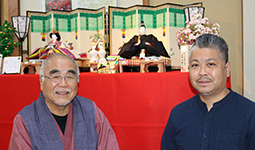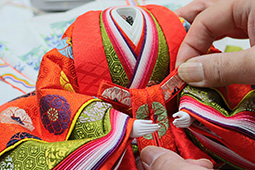March 2022
- English
- 日本語
Kyoto Hina Dolls

Ohashi-Ippou’s masterpiece, the Suzakuoji daigokuden sokutai bina (Different type from that exhibited at the Kyoto State Guest House) 
Tairei-bina, which are Hina Ningyo representing His Majesty the Emperor and Her Majesty the Empress at the Ceremonies of the Accession to the Throne of His Majesty. The male hina doll (right) wears the korozen no goho, while the female hina doll wears a so-called junihitoe.

Second- and third-generation Ohashi-Ippou craftsmen Ohashi Yoshio (left) and Ohashi Yoshiyuki (right) 
The female hina doll’s junihitoe color combinations are based on the traditional seasonal combinations known as kasane no irome

Inspired by ancient imperial ceremonies and events, Kyoto Hina Ningyo (Hina dolls) are elegant and refined.

March 3 is Hina Matsuri (Doll Festival) day in Japan. In families with daughters, Hina Ningyo are displayed to express a wish for their healthy growth. This custom spread in the Edo period (early seventeenth to middle of the nineteenth century). Dolls started to be put on display in the houses of court nobles and samurai, later becoming popular among ordinary people too (see here)
When the Hina Matsuri first began to spread among nobles and samurai, only the male and female hina dolls in the likeness of the Emperor and Empress were used. However, as the dolls’ popularity grew, more dolls were added to represent the ladies serving at court and the court musicians playing gagaku (Japanese traditional court music), causing the stand for the dolls and other decorations to expand to three, five, and finally seven tiers.
In the Edo period, most Hina Ningyo were made in Kyoto, the center of court culture since the Heian period (late eighth to late twelfth century). Hina Ningyo called Kyo-bina, rooted in court culture, are still produced in various Kyoto workshops. Among them, the Ohashi-Ippou workshop makes Hina Ningyo based on yusokukojitsu costume traditions and conventions that have been passed down in the court since the Heian period. These dolls are highly admired for their elegance, refinement, and how they perfectly reproduce the world of the ancient imperial court.
Hina Ningyo are completely made by hand, and craftsmen specialize in parts such as head, hair, limbs, and costumes. There are actually about 3,000 steps to completion. Following in the footsteps of his father, Ohashi Yoshio is a second-generation ningyo-shi (doll artisan) whose role it is to combine heads, limbs, and other parts made by craftsmen to complete the dolls. Ningyo-shi are also responsible for tasks such as making the torso, designing the kimono, and dressing the dolls.
Ohashi says, “The elegance of the dolls depends greatly on the details, such as the position of the head, the posture, hand positions, and such. For the kimono of dolls we use the same silk fabric as used for real kimono.”
An example of these kimono worn by Hina Ningyo according to yusokukojitsu is the korozen no goho for the male hina doll. This is a sokutai* that may be worn only by the Emperor. It has a yellowish-brown color symbolic of the sun’s light called korozen, and includes patterns of paulownia, bamboo, the phoenix, and so forth. Ohashi reproduced the kimono to the greatest extent possible. His Majesty the Emperor wore the korozen no goho at the Ceremonies of the Accession to the Throne of His Majesty the Emperor on October 22, 2019.**

An example of a kimono for the female hina doll is the so-called junihitoe,*** which is the highest level of formal attire for women at the court. The junihitoe is a kimono that layers garments with various colors, adopting combinations selected from more than 100 types of seasonal color combinations, known traditionally as kasane no irome.**** In the spring when the Hina Matsuri is held, for example, the color combination is based on crimson to give a gorgeous feel.

Ohashi has made many Hina Ningyo, but one of his most important works is the Suzakuoji daigokuden sokutai bina series. Suzakuoji was Kyoto’s main street in the Heian period, measuring some 84 meters wide and about four kilometers long from north to south. At its northernmost end lay the Daigokuden in the Imperial Palace where national ceremonies and events were held. Ohashi’s workshop is located near the place where the Daigokuden used to be. This series, whose name reflects the pride Ohashi takes in Kyoto’s history and traditions, is a work that crystallizes craftsmanship built on yusokukojitsu knowledge accumulated over many years. One example is displayed at the Kyoto State Guest House, adding color to banquets and other entertainments for state guests.
Ohashi says, “Traditions that have been passed down in the imperial court for more than 1,000 years are used in our doll making, and we are studying hard every day to pass them on to the future.”
Ohashi’s son as the third generation is also engaged in making dolls in their workshop. Through Hina Ningyo, Kyoto traditions are passed on to the next generation.
* The sokutai is one of the highest levels of formal attire for men at the court.
** See Highlighting Japan February 2020: https://www.gov-online.go.jp/eng/publicity/book/hlj/html/202002/202002_09_en.html
*** Officially, this formal kimono consists of itsutsuginu, karaginu, and mo. The prefix “on-” is only used when the dress is for the Empress, making it on-itsutsuginu, on-karaginu, and on-mo.
**** See Highlighting Japan October 2020: https://www.gov-online.go.jp/eng/publicity/book/hlj/html/202010/202010_06_en.html

